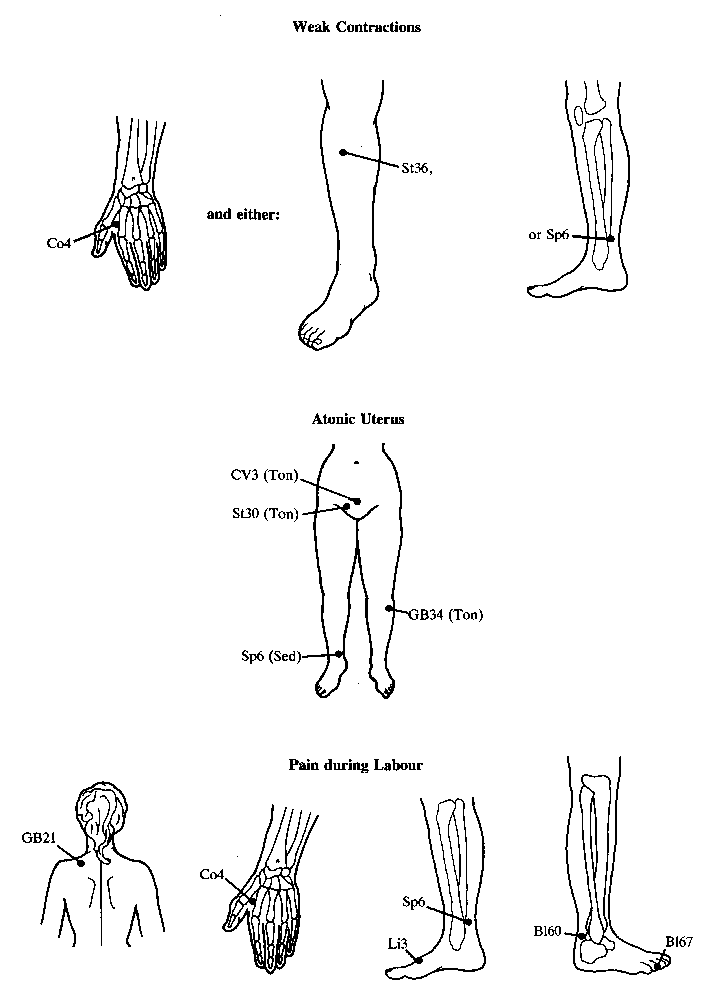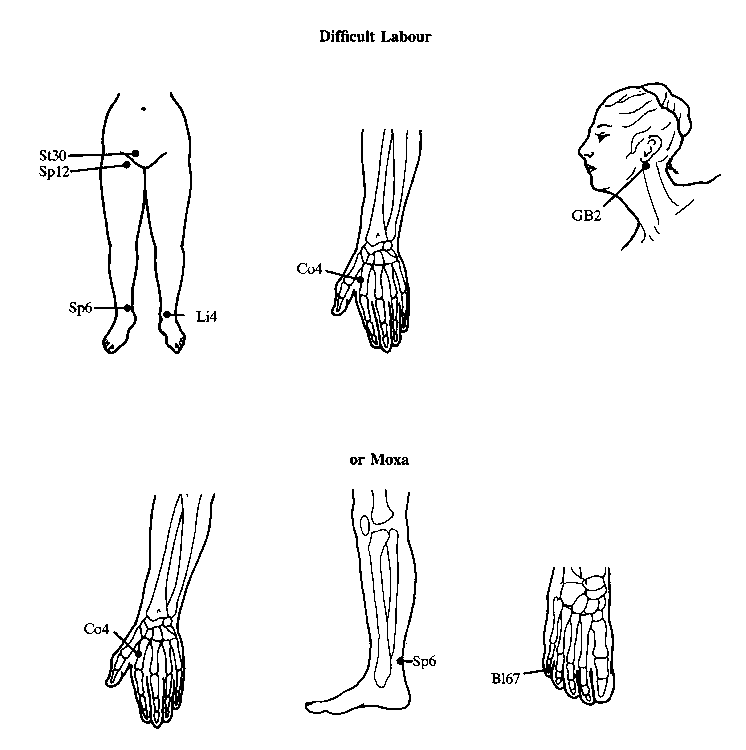One aspect of acupuncture which has particularly caught the public's imagination during recent years is its application for pain during childbirth. Many Chinese practitioners to whom I have spoken tend to regard childbirth as a natural function, to be interfered with as little as possible, and feel that acupuncture should be used mainly when there is a weakness in the uterine contractions, when its application can be regarded as assisting nature rather than interfering with its function. To the best of my knowledge acupuncture in this respect has not been used to any great extent in the Western world, but Dr Wilfred Pererra of Sri Lanka has presided over several thousand cases with extremely impressive results.
Normal childbirth may be divided into three stages:
In the case of malposition of the foetus, a well-known treatment is the use of moxa on Bl67 (Zhiyen) for twenty minutes every day for four to five days. The patient is usually presented with a moxa-roll or green-stick moxa and instructed in how to perform this for herself. This works particularly well in cases of breech presentation, when the patient will frequently report feeling the baby turn itself into the correct position. It is most effective if used before the 34th week of pregnancy. Another technique, to raise the placenta and the foetus, is moxa (on salt) to Cv8 (Shenque).
To stimulate labour, the basic formula given by most Chinese sources is Bl31 (Shangliao), Bl32 (Ciliao), Co4 (Hegu) and Sp6 (Sanyinjiao), either needle manipulation for fifteen to thirty minutes or electrical stimulation, but alternative combinations have been tried, such as Co4 (Hegu), Sp6 (Sanyinjiao), GB21 (Jianjing) and Bl67 (Zhiyen), or Co4 (Hegu), Sp6 (Sanyinjiao), GV1 (Changqiang) and Sp9 (Yinlingquan).
The object of all these points is to regulate the Qi, move the blood, and strengthen the contractions.
To stimulate the induction, tonification of Co4 (Hegu), Sp6 (Sanyinjiao), Bl32 (Ciliao), Cv4 (Guanyuan) and St36 (Zusanli) is recommended, or possibly Co4 (Hegu), Sp6 (Sanyinjiao), Bl31 (Shangliao) and Li3 (Taichong). As an �experience point, the use of Bl32 (Ciliao) seems preferable to Bl31 (Shangliao).
When there are weak contractions and the cervix is slow to dilate, stimulate either Co4 (Hegu) and St36 (Zusanli) or Co4 (Hegu) and Sp6 (Sanyinjiao), whilst for an atonic uterus tonify St3O (Qichong), GB34 (Yanglingquan), Cv3 (Zhongji) and then sedate Sp6 (Sanyinjiao).

Pain during labour may be treated by either Gb21 (Jianjing), Co4 (Hegu), Sp6 (Sanyinjiao), Li3 (Taichong), Bl60 (Kunlun) and Bl67 (Zhiyen) or Co4 (Hegu), Sp6 (Sanyinjiao), Li3 (Taichong), Bl60 (Kunlun) and Cv4 (Guanyuan). Strong pressure on Bl60 (Kunlun) may also help.

In cases of difficult labour, stimulate Spl2 (Chongmen), Li4 (Zhongfen), St30 (Qichong), Co4 (Hegu), Sp6 (Sanyinjiao) and Gb2 (Tinghui), or moxa Co4 (Hegu) and Sp6 (Sanyinjiao) and burn three cones on Bl67 (Zhiyin).

Ear points may also be used in conjunction with the body points, usually Uterus and Endocrine, with the needles being inserted and stimulated every five minutes for about twenty minutes. Dr Pererra s own treatment, as given at a talk he gave at a British Acupuncture Association Congress, was firstly a sedative needle in Gv2O (Baihui) to relax the patient, and then needles inserted into Co4 (Hegu) bilaterally and into Sp6 (Sanyinjiao) on the opposite side to the doctor.
During the first stage, electro-stimulation was applied to the leg points (Sp6) only, using either a dense/disperse or an interrupted current.
During the second stage, strong manual stimulation was given to Co4 (Hegu).
During the third stage, moxa was applied to Bl60 (Kunlun).
As noted earlier, Dr Pererra attended several thousand cases with marked success, and during his talk he made several pertinent observations,